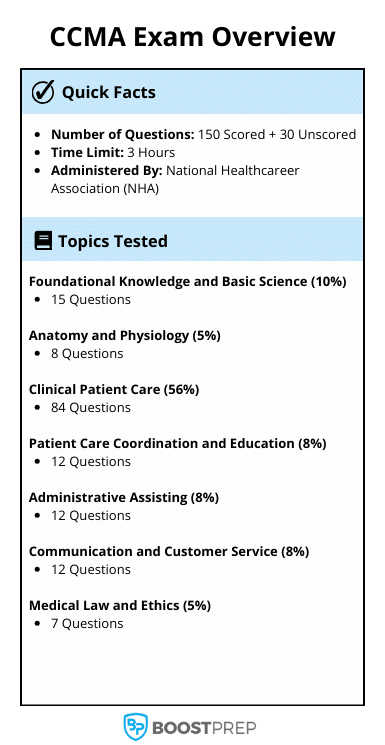CCMA Practice Test
Take our CCMA practice test below. The exam is completely free and will tell you if you are ready for your CCMA medical assistant exam.
To begin, click the “Start Exam” button below!
CCMA Diagnostic Pretest
Exam Summary
0 of 25 Questions completed
Questions:
Information
You have already completed the exam before. Hence you can not start it again.
Exam is loading…
You must sign in or sign up to start the exam.
You must first complete the following:
Results
Results
Time has elapsed
You have reached 0 of 0 point(s), (0)
Earned Point(s): 0 of 0, (0)
0 Essay(s) Pending (Possible Point(s): 0)
Categories
- CCMA Administrative Assisting 0%
- CCMA Anatomy and Physiology 0%
- CCMA Clinical Patient Care 0%
- CCMA Communication and Customer Service 0%
- CCMA Foundation Knowledge and Basic Science 0%
- CCMA Medical Law and Ethics 0%
- CCMA Patient Care Coordination and Education 0%
-
Keep Studying: You will not pass the CCMA exam right now. You need to continue studying for the exam. Take some of our full-length practice exams.
-
Almost There: We recommend that you keep studying. You may be able to pass the CCMA exam right now, but it will be close. Take some of our full-length practice exams.
-
You Are Ready: We feel you are ready for the CCMA exam. You can continue to study if you would like to be safe. Take some of our full-length practice exams.
- 1
- 2
- 3
- 4
- 5
- 6
- 7
- 8
- 9
- 10
- 11
- 12
- 13
- 14
- 15
- 16
- 17
- 18
- 19
- 20
- 21
- 22
- 23
- 24
- 25
-
Question 1 of 25
1. Question
CorrectIncorrect -
Question 2 of 25
2. Question
CorrectIncorrect -
Question 3 of 25
3. Question
CorrectIncorrect -
Question 4 of 25
4. Question
CorrectIncorrect -
Question 5 of 25
5. Question
CorrectIncorrect -
Question 6 of 25
6. Question
CorrectIncorrect -
Question 7 of 25
7. Question
CorrectIncorrect -
Question 8 of 25
8. Question
CorrectIncorrect -
Question 9 of 25
9. Question
CorrectIncorrect -
Question 10 of 25
10. Question
CorrectIncorrect -
Question 11 of 25
11. Question
CorrectIncorrect -
Question 12 of 25
12. Question
CorrectIncorrect -
Question 13 of 25
13. Question
CorrectIncorrect -
Question 14 of 25
14. Question
CorrectIncorrect -
Question 15 of 25
15. Question
CorrectIncorrect -
Question 16 of 25
16. Question
CorrectIncorrect -
Question 17 of 25
17. Question
CorrectIncorrect -
Question 18 of 25
18. Question
CorrectIncorrect -
Question 19 of 25
19. Question
CorrectIncorrect -
Question 20 of 25
20. Question
CorrectIncorrect -
Question 21 of 25
21. Question
CorrectIncorrect -
Question 22 of 25
22. Question
CorrectIncorrect -
Question 23 of 25
23. Question
CorrectIncorrect -
Question 24 of 25
24. Question
CorrectIncorrect -
Question 25 of 25
25. Question
CorrectIncorrect
Pass Your Exam.
Guaranteed.
CCMA Prep
- 4 Full-Length Exams
- 720+ Practice Questions
- 700+ Flashcards
"Questions on the practice exams were similar to the actual CCMA exam. I passed!"
CCMA Test Overview
CCMA stands for Certified Clinical Medical Assistant. The National Healthcareer Association (NHA) administers the exam.
Here is a quick breakdown of the exam:
- Number of Questions: 150 Scored + 30 Unscored
- Time Limit: 3 Hours
CCMA questions are broken down into 7 sections:
- Foundational Knowledge and Basic Science: 15 Questions
- Anatomy and Physiology: 8 Questions
- Clinical Patient Care: 84 Questions
- Patient Care Coordination and Education: 12 Questions
- Administrative Assisting: 12 Questions
- Communication and Customer Service: 12 Questions
- Medical Law and Ethics: 7 Questions
Foundational Knowledge and Basic Science (10%)
This section consists of 15 questions on the following subtopics:
- Health Care Systems and Settings
- Medical Terminology
- Basic Pharmacology
- Nutrition
- Psychology
Overall, this section makes up about 10% of the total exam.
Anatomy and Physiology (5%)
This section consists of 8 questions on the following subtopics:
- Body Structures and Organ Systems
- Pathophysiology and Disease Processes
Overall, this section makes up about 5% of the total exam.
Clinical Patient Care (56%)
This section consists of 84 questions on the following subtopics:
- Patient Intake and Vitals
- General Patient Care
- Infection Control and Safety
- Point of Care Testing and Laboratory Procedures
- Phlebotomy
- EKG and Cardiovascular Testing
Overall, this section makes up about 56% of the total exam. This section will make up the bulk of the exam.
Patient Care Coordination and Education (8%)
This section consists of 12 questions on the following subtopics:
- Education Delivery Methods, Instructional Techniques, Etc..
- Available Resources
- Preventive Medicine and Screenings
- Clinical Quality Measures
Overall, this section makes up about 8% of the total exam.
Administrative Assisting (8%)
This section consists of 12 questions on the following subtopics:
- Types of Office Visits
- Practice Management Systems
- Medical Records
- Chart Review
- Diagnostic and Procedural Codes
Overall, this section makes up about 8% of the total exam.
Communications and Customer Service (8%)
This section consists of 12 questions on the following subtopics:
- Patient Characteristics Affecting Communication
- Communication Styles
- Active Listening and Coaching Techniques
- General Communication Etiquette
Overall, this section makes up about 8% of the total exam.
Medical Law and Ethics (5%)
This section consists of 7 questions on the following subtopics:
- Laws and Regulations
- Patient’s Bill of Rights
- Informed and Implied Consent
- Criminal and Civil Acts
Overall, this section makes up about 5% of the total exam.
Practice for the CCMA with the Right Tools
1. Simulated Exams
One of the best ways to prepare for the CCMA medical assistant exam is by using simulated exams.
Our simulated exams take the following into account:
- Number of Questions
- Time Limits
- Types of Questions
- Topics of Questions
Taking simulated exams is a great way to get rid of any test anxiety you may have and go into the exam 100% prepared.
2. Detailed Answer Explanations
We always recommend reading our detailed answer explanations after taking each exam. Our answer explanations will help you better understand important concepts.
Every question we offer includes a detailed answer explanation. You can learn from each answer explanation to better prepare for your exam.
3. Flashcards
For the CCMA exam, flashcards are one of the best ways to study. We offer 700+ flashcards to prepare for your exam. Our flashcards will review the most important things you should know before heading into your exam.
You can choose to review each flashcard individually or you can “speed study” by skimming the whole set at once.
Tips and Tricks for CCMA Practice
Preparing for the CCMA can be overwhelming. Here are some tips and tricks to keep in mind:
- Take a Diagnostic Exam: It is important to get a baseline for where you stand. Our diagnostic exam above is a great place to start.
- Narrow Down Problem Areas: If you can narrow down which areas you struggle with, you can study more efficiently. If you really struggle with the Administrative Assisting section, you can focus on that instead of another section you are already good at.
- Focus on Answer Explanations: It can be really tempting to close out of your exam after you finish it and see your score. Fight that urge! Make sure you review each answer explanation to maximize your learning and retention.
- Take a Final Exam: Make sure you take a final exam before the actual exam. This should be your final “check” before taking the real thing.
Frequently Asked Questions
There will be 150 scored questions and 30 unscored questions. You will not know which questions are unscored, so it is important to try to answer every question correctly.
You will have 3 hours to take the CCMA exam.
The CCMA is scored on a scale of 200 to 500. A passing score is 390. This means you must answer 78% of the questions correctly.
No, you will not be able to take any breaks on the CCMA exam.
You will need to pay a fee of $160 to take the exam.
You can retake the CCMA exam up to 3 times. However, you will have to wait 30 days between each attempt.
Patricia has been a registered nurse for almost 40 years. She has a vast wealth of experience and knowledge when it comes to nursing and education.
Patricia has created and taught classes for different healthcare providers and has her Ph.D. in Natural Health.
Learn more about Patricia Bratianu.



